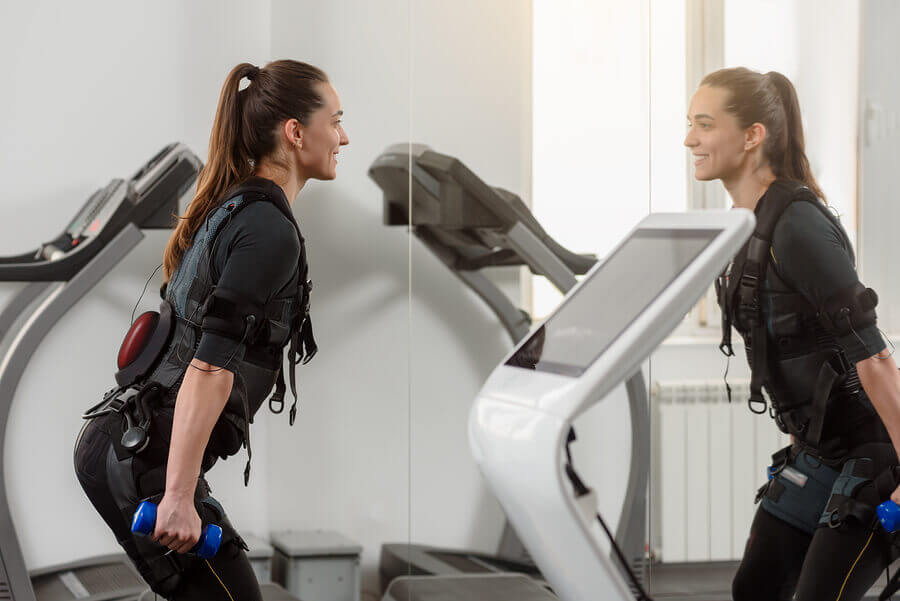Electro-Muscle Stimulation

The end of the nineties opened the world to the infamous electro-stimulation belts to develop ab muscles. However many people were ultimately disappointed with these TV products. But, electro-muscle stimulation actually works and can enhance workouts.
Today, we have technology at our fingertips that’s much more advanced. People use electro-muscle stimulation for two professional purposes: therapeutic treatments or physical training. But, there are still a lot of myths and doubts about using electro-stimulation to build muscle.
Electro-muscle stimulation workouts
The concept is simple: this technique uses a tool called an electro-simulator to release controlled electrical charges to help build muscle. The system shocks specific muscles or a muscle group.
The technology hails from the seventies from the Soviet Union. Initially, people used electricity to build muscle mass in astronauts. During that time, the therapy was donned “Russian currents” or “Kotz”.
Afterward, the technique spread to the sports world as well as to popular culture. But…does it really help with muscle development?
Electricity for more efficient muscles
Electro-stimulation actually does encourage stronger muscles–but not in the way you might think it does. The technique doesn’t help you grow muscle mass thanks to a couple of electrical charges. Instead, muscles can perform better thanks to more integral contractions.

In addition, electro-stimulation can also help tone the body to a certain extent. You could say that the stimulation yields better performance, which makes it easier to tone muscle. But, forget about building muscle by just sitting there and clicking a button.
On a different note, electro-muscle stimulation is a useful method for combating muscular atrophy in the event of an injury or similar condition. With electro-stimulation, muscles can still remain somewhat active while being still. In addition, electricity helps improve joint stability and works deep muscles, which is hard to do by simply exercising.
Great asset for therapeutic treatments
Electro-stimulation also has amazing benefits for muscle recuperation. The therapy serves to treat muscular diseases, contractures, ligament injuries, and other joint problems as well. The therapy is also a common option to treat pain as well.
This treatment activates muscles without needing to move them. Therapies might direct electrical currents to specific areas in the body, or work on a general set of muscles at the same time.
Just as we mentioned earlier, electro-stimulation barely affects muscle build. Instead, the shocks generate testosterone and burns calories, but only to a small extent.
Improving athletic performance
Electricity is a complementary element that can help muscles contract and respond better. However, it won’t automatically produce more agile athletes. At the end of the day, the charges don’t actually improve muscle coordination.
But, an athlete or a person who regularly exercises can use local electrical impulses to improve their muscle response and benefit from an extra impulse. In other words, you should still continue your gym routines and normal workouts; they’re not only recommended but necessary to enjoy the benefits that electro-muscle stimulation can offer.
Professional athletes can also use electro-stimulation to treat injuries to keep muscles from being completely inactive. By maintaining a small level of muscle activity, their recovery can progress more smoothly.

Limitations and side-effects of electro-muscle stimulation
Electro-stimulation treatments only include two sessions per week in order to prevent negative side-effects. Alternatively, some individuals may not even be recommended electro-muscle stimulation treatments.
People who suffer from heart diseases, tumors or tendinitis shouldn’t undergo electro-stimulation treatments. In addition, pregnant women, people with implants or those who suffer from tendinitis should also look for different alternatives.
Vest sessions range from 10 to 20 minutes in length depending on the patient’s background and resistance levels. A single session will keep muscles active for 72 hours. If you undergo a session, you should take advantage of the following 72 hours to exercise.
The end of the nineties opened the world to the infamous electro-stimulation belts to develop ab muscles. However many people were ultimately disappointed with these TV products. But, electro-muscle stimulation actually works and can enhance workouts.
Today, we have technology at our fingertips that’s much more advanced. People use electro-muscle stimulation for two professional purposes: therapeutic treatments or physical training. But, there are still a lot of myths and doubts about using electro-stimulation to build muscle.
Electro-muscle stimulation workouts
The concept is simple: this technique uses a tool called an electro-simulator to release controlled electrical charges to help build muscle. The system shocks specific muscles or a muscle group.
The technology hails from the seventies from the Soviet Union. Initially, people used electricity to build muscle mass in astronauts. During that time, the therapy was donned “Russian currents” or “Kotz”.
Afterward, the technique spread to the sports world as well as to popular culture. But…does it really help with muscle development?
Electricity for more efficient muscles
Electro-stimulation actually does encourage stronger muscles–but not in the way you might think it does. The technique doesn’t help you grow muscle mass thanks to a couple of electrical charges. Instead, muscles can perform better thanks to more integral contractions.

In addition, electro-stimulation can also help tone the body to a certain extent. You could say that the stimulation yields better performance, which makes it easier to tone muscle. But, forget about building muscle by just sitting there and clicking a button.
On a different note, electro-muscle stimulation is a useful method for combating muscular atrophy in the event of an injury or similar condition. With electro-stimulation, muscles can still remain somewhat active while being still. In addition, electricity helps improve joint stability and works deep muscles, which is hard to do by simply exercising.
Great asset for therapeutic treatments
Electro-stimulation also has amazing benefits for muscle recuperation. The therapy serves to treat muscular diseases, contractures, ligament injuries, and other joint problems as well. The therapy is also a common option to treat pain as well.
This treatment activates muscles without needing to move them. Therapies might direct electrical currents to specific areas in the body, or work on a general set of muscles at the same time.
Just as we mentioned earlier, electro-stimulation barely affects muscle build. Instead, the shocks generate testosterone and burns calories, but only to a small extent.
Improving athletic performance
Electricity is a complementary element that can help muscles contract and respond better. However, it won’t automatically produce more agile athletes. At the end of the day, the charges don’t actually improve muscle coordination.
But, an athlete or a person who regularly exercises can use local electrical impulses to improve their muscle response and benefit from an extra impulse. In other words, you should still continue your gym routines and normal workouts; they’re not only recommended but necessary to enjoy the benefits that electro-muscle stimulation can offer.
Professional athletes can also use electro-stimulation to treat injuries to keep muscles from being completely inactive. By maintaining a small level of muscle activity, their recovery can progress more smoothly.

Limitations and side-effects of electro-muscle stimulation
Electro-stimulation treatments only include two sessions per week in order to prevent negative side-effects. Alternatively, some individuals may not even be recommended electro-muscle stimulation treatments.
People who suffer from heart diseases, tumors or tendinitis shouldn’t undergo electro-stimulation treatments. In addition, pregnant women, people with implants or those who suffer from tendinitis should also look for different alternatives.
Vest sessions range from 10 to 20 minutes in length depending on the patient’s background and resistance levels. A single session will keep muscles active for 72 hours. If you undergo a session, you should take advantage of the following 72 hours to exercise.
All cited sources were thoroughly reviewed by our team to ensure their quality, reliability, currency, and validity. The bibliography of this article was considered reliable and of academic or scientific accuracy.
- Anna Junqué Jiménez; Vicent Esteve Simó; Ester Tomás Bernaveu; Óscar Paz López; Gorka Iza Pinedo; Inés Luceño Solé; Marisa Lavado Sempere; Manel Ramírez de Arellano. 2014. Electroestimulación muscular. Servicio de Nefrologia Hospital de Terrassa. Extraído de: http://scielo.isciii.es/pdf/enefro/v17n4/05_original4.pdf
- Dufary Alegría Rivera. 2011. Electroestimulación neuromuscular. Extraído de: http://bibliotecadigital.univalle.edu.co/bitstream/10893/3874/4/0450258.pdf
This text is provided for informational purposes only and does not replace consultation with a professional. If in doubt, consult your specialist.








